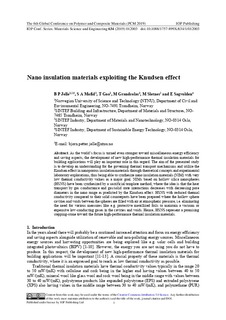| dc.contributor.author | Jelle, Bjørn Petter | |
| dc.contributor.author | Alex Mofid, Sohrab | |
| dc.contributor.author | Gao, Tao | |
| dc.contributor.author | Grandcolas, Mathieu | |
| dc.contributor.author | Sletnes, Malin | |
| dc.contributor.author | Sagvolden, Espen | |
| dc.date.accessioned | 2019-10-18T07:04:03Z | |
| dc.date.available | 2019-10-18T07:04:03Z | |
| dc.date.created | 2019-10-15T17:57:24Z | |
| dc.date.issued | 2019 | |
| dc.identifier.citation | IOP Conference Series: Materials Science and Engineering. 2019, 634 1-7. | nb_NO |
| dc.identifier.issn | 1757-8981 | |
| dc.identifier.uri | http://hdl.handle.net/11250/2623000 | |
| dc.description.abstract | As the world's focus is turned even stronger toward miscellaneous energy efficiency and saving aspects, the development of new high-performance thermal insulation materials for building applications will play an important role in this regard. The aim of the presented study is to develop an understanding for the governing thermal transport mechanisms and utilize the Knudsen effect in nanoporous insulation materials through theoretical concepts and experimental laboratory explorations, thus being able to synthesize nano insulation materials (NIM) with very low thermal conductivity values as a major goal. NIMs based on hollow silica nanospheres (HSNS) have been synthesized by a sacrificial template method, where the idea is that the heat transport by gas conductance and gas/solid state interactions decreases with decreasing pore diameters in the nano range as predicted by the Knudsen effect. HSNS with reduced thermal conductivity compared to their solid counterparts have been prepared where the hollow sphere cavities and voids between the spheres are filled with air at atmospheric pressure, i.e. eliminating the need for various measures like e.g. protective metallized foils to maintain a vacuum or expensive low-conducting gases in the cavities and voids. Hence, HSNS represent a promising stepping-stone toward the future high-performance thermal insulation materials. | nb_NO |
| dc.language.iso | eng | nb_NO |
| dc.publisher | IOP Publishing | nb_NO |
| dc.rights | Navngivelse 4.0 Internasjonal | * |
| dc.rights.uri | http://creativecommons.org/licenses/by/4.0/deed.no | * |
| dc.title | Nano Insulation Materials Exploiting the Knudsen Effect | nb_NO |
| dc.type | Journal article | nb_NO |
| dc.type | Peer reviewed | nb_NO |
| dc.description.version | publishedVersion | nb_NO |
| dc.source.pagenumber | 1-7 | nb_NO |
| dc.source.volume | 634 | nb_NO |
| dc.source.journal | IOP Conference Series: Materials Science and Engineering | nb_NO |
| dc.identifier.doi | 10.1088/1757-899X/634/1/012003 | |
| dc.identifier.cristin | 1737346 | |
| dc.relation.project | Norges forskningsråd: 250159 | nb_NO |
| dc.description.localcode | Content from this work may be used under the terms of the Creative Commons Attribution 3.0 licence. Any further distribution of this work must maintain attribution to the author(s) and the title of the work, journal citation and DOI. Published under licence by IOP Publishing Ltd. | nb_NO |
| cristin.unitcode | 194,64,91,0 | |
| cristin.unitname | Institutt for bygg- og miljøteknikk | |
| cristin.ispublished | true | |
| cristin.fulltext | original | |
| cristin.qualitycode | 1 | |

